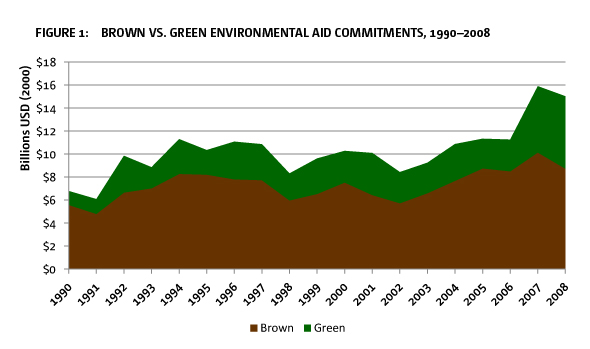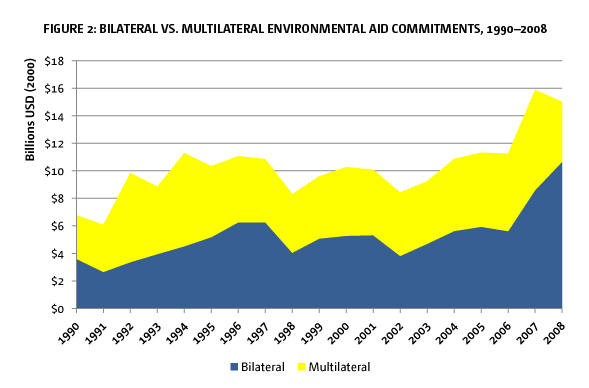Research Brief
Trends in Environmental Aid
Global Issues, Bilateral Delivery
- Levels of environmental aid for global issues are increasing.
- Environmental aid is increasingly allocated through bilateral aid agencies rather than through the multilateral channels created for this purpose.
 A consistent demand of developing countries has been that any requirement to pursue economic development in a way that is less damaging to the global environment be paid for, in part, by developed countries. Environmental aid flows have increased significantly, from roughly US$10 billion per year in the early 2000s, to roughly US$15 billion per year by the end of the decade. However, these totals mask changing trends in the delivery of environmental aid.
A consistent demand of developing countries has been that any requirement to pursue economic development in a way that is less damaging to the global environment be paid for, in part, by developed countries. Environmental aid flows have increased significantly, from roughly US$10 billion per year in the early 2000s, to roughly US$15 billion per year by the end of the decade. However, these totals mask changing trends in the delivery of environmental aid.
Analysis of the AidData database, which now contains more than one million project level records, uncovers two key trends in environmental aid. First, an increasing proportion of environmental aid is being allocated to projects designed to address global environmental issues. Second, environmental aid is increasingly being allocated bilaterally, through national aid agencies, rather than multilaterally, through the international organizations and channels created for this purpose.
From local to global issues
Environmental projects can be divided into ‘green’ and ‘brown’ categories. Brown projects are those designed to generate primarily local environmental benefits. Such projects include water sanitation, desalinatio,n and solid waste treatment. Green projects are those designed to generate benefits that are substantially external to the recipient country, and may include projects such as climate change mitigation, biodiversity preservation, and ozone preservation.
While overall levels of brown aid remained relatively constant during the 2000s, levels of green aid doubled, increasing from roughly US$3 billion per year to roughly US$6 billion (Figure 1). As a proportion of all environmental aid, green aid grew from 20 per cent in the early 1990s to 40 per cent in the late 2000s. These trends likely reflect recent international commitments targeting climate change.

Bilateral and multilateral aid
Between 1990 and 2008 the amount of environmental aid channeled through multilateral institutions increased by roughly 16 per cent. In contrast, bilateral environmental aid levels more than doubled over the same period, going from US$3.6 billion to US$6.5. In relative terms, 58 per cent of environmental aid was allocated through multilateral agencies from 1990–94. By 2005–08, this figure had dropped to 42 per cent (Figure 2).

This trend results in part to an increase in the proportion of green aid being delivered bilaterally. From 1990–94, donors split their allocation of green aid roughly evenly between multilateral and bilateral channels. By 2005–08, 70 per cent of green aid was being allocated though bilateral agencies.
Why are donors opting for bilateral aid?
Multilateral institutions reduce transaction costs for the donors and diminish political uncertainty, potentially dampening the sort of free rider problems that often plague global environmental governance. Thus, it is surprising to see an increased emphasis on bilateral aid channels at the same time that donors are increasingly emphasizing global environmental issues. It is important to question why this is occurring.
There are a number of cost considerations when it comes to delivering aid through multilateral institutions, which may explain the trend towards delivering environmental aid bilaterally.
- Delivering aid multilaterally can lead to agency slack, which occurs when agency behavior departs from donor preferences.
- There are costs involved in donors monitoring the work of multilateral institutions.
- Weak or stalling multilateral projects may lead donors to believe that their aid would be more effective if delivered bilaterally.
- Donors may resort to bilateralism if they believe that recipients’ bargaining position in multilateral institutions is increasing.
A future for multilateral climate aid?
Multilateral co-operation is essential for climate governance. Fortunately, given the establishment of major new multilateral funds for climate mitigation and adaptation, it is no longer plausible to argue that donors lack multilateral vehicles through which to channel climate finance, or environmental aid more broadly.
While the creation of new multilateral funds under the UN umbrella has been much celebrated, donors have been reluctant actually to use them; the most active multilateral funds remain those managed by the World Bank.
- Efforts to democratize institutional funding frameworks, giving recipients greater voice, may come at the cost of reduced donor participation in such institutions.
- A diminished role for multilateral institutions may diminish the effectiveness of climate finance.
Giving donors more control over UN-managed multilateral channels may encourage their greater use. However, this will have the inevitable consequence of lessening the already weak voice of recipient countries, and is likely to exacerbate the questions of legitimacy and fairness plaguing climate governance that motivated the very creation of new, UN-managed funds.
 Join the network
Join the network